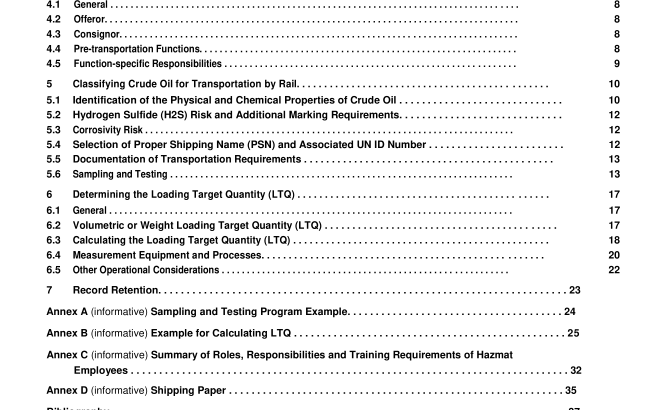API RP 3000:2014 pdf free download.Classifying and Loading of Crude Oil into Rail Tank Cars
5 Classifying Crude Oil for Transportation by Rail
5.1 Identification of the Physical and Chemical Properties of Crude Oil
5.1.1 General The identification of the physical and chemical characteristics of crude oil (3.6) is conducted for the purpose of determining the proper hazardous material classification and the assignment of Packing Group (3.21 ) of the crude oil and subsequent selection of the package to be utilized. See Table 1 .
Identifying the physical and chemical properties of crude oil shipped by rail is required by government regulations. Each package used for the shipment of hazardous materials shall be designed, constructed, maintained, filled, its contents so limited, and closed, so that under conditions normally incident to transportation there will be no identifiable (without the use of instruments) release of hazardous materials to the environment, and that the effectiveness of the package will not be substantially reduced.
5.1.2 Reasons for Classification Classification of a hazardous material (3.1 2) is the first step in preparing a consignment for transport. Classification is the determination of basic shipping information. Basic information includes:
— UN ID number;
— proper shipping name (technical chemical name);
— primary hazard class;
— subsidiary hazard class/risk(s);
— Packing Group. Misclassification of a hazardous material could lead to use of an unauthorized rail tank car that may lack the required safety features necessary to safely transport the crude oil, as well as insufficient development of safety and security plans and the communication of inaccurate information to emergency responders.
5.1.3 Determination of Classification The offeror of crude oil for transportation in commerce shall ensure that the crude oil has been tested and classified in accordance with government regulations prior to being offered into transport by rail.
When determining the hazard class of crude oil, a determination shall be made that the crude oil does not meet the definition of a flammable gas prior to being classified as a Class 3 flammable liquid (3.1 7). Some crude oils may not be classified as a hazardous material (see 5.1 .5).
Within the USA, a flammable gas is defined in 49 CFR 1 73.1 1 5 as any material which is a gas at 20 °C (68 °F) or less and 1 01 .3 kPa (1 4.7 psia) of pressure (a material which has a boiling point of 20 °C (68 °F) or less at 1 01 .3 kPa (1 4.7 psia)) which: 1 ) Is ignitable at 1 01 .3 kPa (1 4.7 psia) when in a mixture of 13 % or less by volume with air; or 2) Has a flammable range at 101 .3 kPa (1 4.7 psia) with air of at least 1 2 % regardless of the lower limit. Except for aerosols, the limits specified in [these paragraphs] shall be determined at 1 01 .3 kPa (1 4.7 psia) of pressure and a temperature of 20 °C (68 °F) in accordance with the ASTM E681 -85, Standard Test Method for Concentration Limits of Flammability of Chemicals, or other equivalent method approved by the [PHMSA] Associate Administrator. Within Canada, a flammable gas is defined in TDGR section 2.1 3 as a substance that at 50 °C has a vapor pressure greater than 300 kPa or that is completely gaseous at 20 °C at an absolute pressure of 101.3 kPa and that is:
a) compressed (other than in solution) so that when it is packaged under pressure for transport it remains entirely gaseous at 20 °C;
b) liquefied so that when it is packaged for transport it is partially liquid at 20 °C;
c) refrigerated so that when it is packaged for transport it is made partially liquid because of its low temperature;
d) in solution so that when it is packaged for transport it is dissolved in a solvent.
5.1.4 Assignment of Packing Group (PG) Once crude oil is classified as a flammable liquid (Class 3) (3.1 7) and prior to being offered for transportation by rail in rail tank cars, the flash point and initial boiling point shall be determined to establish the PG (3.21 ). See 5.6 for sampling and testing frequency. See Table 1 for the criteria for assignment of PG for a Class 3 flammable liquid.API RP 3000 pdf download.API RP 3000:2014 pdf free download
